|
Weird beliefs
Japan and numbers
The numbers have a big signification once you write them in japanese letters(kanji).
The most feared number is four which means death.
Car plates will hardly carry a number four on it, usually the owner pays extra money to change the plate number especially
if the number four is followed by the nine which together will mean ''you'll die'', for example 4219 read
as shi ni iku ''you're going to die'' .
Hospitals and most buildings that have four floors only start to count as first floor from the second, so the building
won't end with the number four.
Money to the deceased's family
It's a tradition in Japan to give some money in a special envelope to the family of a dead person, evem if the one who
died was just a neighboor you never talked to, it's a way to express your condolences and to help the family paying the funeral.
But there are rules for the money as well;
The money to be given varies from 5.000yen(around 60 us dollars) to 50.000yen(around 600 us dollars) or more
depending on the relation to the passed one.
The number of banknotes can't be in pairs if sums four all together and it can't be the total sum of 4.000 or 40.000
yen it would be offensive to the family and they probably would get you out of their house or the funeral.
So the safest would give three bills of 1.000 yen each or three of 5.000 yen each.
Kids and money as a New Year Eve and Children's Day present.
Kids also get money in envelopes but for the little ones, grandparents and other relatives usually give them three bills
of 1.000 yen(around 11 us dollars) to 10.000yen(around 110 us dollars)
Mochi and the New Year Eve Tradition
Mochi(rice cake) is made from smashed rice, white or artificially coloured, sweet or not, fried or served with soy
bean soup(misoshiro), sticky, bad for young children and aged people, if someone choke with it the only way to get the sticky
mass out of your throat is using a vacuum cleaner.
But even knowing that, they all eat lots of it when a new year begin tradition says that eating mochi keeps one wealthy
for the entire year.
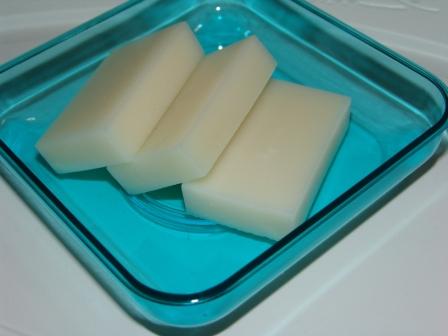
|
| Mochi (rice cake) |
Flying Carp
Koinobori is a popular tradition to fly kite to celebrate children's Day(Japanese holiday on May, see Holiday Calendar),
the fish Carp is known as a powerful swimmer therefore has become a symbol of children growing up strong and healthy,
you can view them hanging out from every pole in Japan, parents will hang the same number of carps to the number of
male kids they have in front of their houses or even attach carps kite to their car.
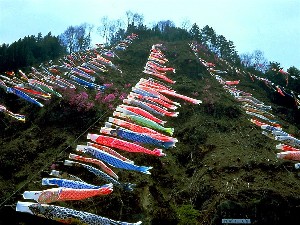
|
| Koinobori Festival |
More Odd Superstitions
House floor plan
Kaso means Fortune telling by floor plan, Japanese think that the plan of a house influences its dweller's
fortune.
THe house entrance can't be built on the northeast of the house or it will conjure lellish monster, know as Oni(devil
mythological monster with three eyes and horns).
Tatami mat borders
Step on the cloth border of the tatami floor mats brings bad luck.
Sleeping toward the North
Sleeping with your head toward the North brings bad luck too because only dead bodies are laid in that position.
Funeral Car
When a funeral car passes in front of you superstition says you have to hide your thumb.
This is because thumb in Japan is called ''parent finger'' (''Oya yubi''), so they believe that if they don't
hide their thumb their own parents will die soon.
Salt on the door step
If a homeless knock at the door begging for something they throw salt by the door steps after he leaves to off evil
spirits and poverty.
Lie down after eating
If you lie die immediately after eating you will turn into a cow.
Fried eel and melon
Eating both of these two foods in the same meal will poison your spirit and lead you to death.
Gata Strap
To break the strap of your Gata, wooden sandle or Zori(all types of shoes) is a bad luck(like breaking a mirror
in a Western country).
Whistle at night
''Yoru ni kuchibiru o fuku to hebi ga kuru'' (If you whistle at night a snake will come to you).
In the Edo period(1603-1867), the whistle was a sign used by burglars to communicate and warn each other, whistling
at night became associated with inviting intruders and thieves into your home, the snake is a symbol of evil and misfortune.
Clipping your fingernails at night
Also another superstittion created in the Edo period was that one couldn't cut nails at night because
it was too dark to see properly, but it became a belief that if you clip your nails at night you won't be able to be with
your parents when they pass away, in Japanese you say ''Yotsume'' and it sounds like ''Yo o tsumeru'' which
means ''to cut short a life''.
Cut hair after dark
Also a very ancient superstition that says if you cut your hair after nightfalls inside your house ghosts will make their
way into it.
Sick and potted plants
When visitng someone staying in a hospital bringing potted plants to the sick is a bad luck because potted plants symbolizes
that the patient will be rooted in the hospital, prolonging his illness, so they only bring cut flowers as a gift.
Bloodtypes
Many years ago a Japanese doctor researched the relation between the bloodtype and personality and he believed that it
had great influences over ones personality, even after many doctors in the modern days claimed he was wrong the Japanese kept
believing in it, that's why when you watch TV news early in the morning in Japan you'll be able to see what the TV channel
has predicted to each bloodtype for the day, if the person will have luck or not and which color of clothes one should be
wearing that day.
After funeral
After attending a funeral guests must have salt sprinkled on them before entering their homes as a purification rite
and this ceremony is done to remove the spirit of the person who died, which may follow them home from the funeral.
Mirrors
Many Japanese cover their bedroom mirrors at night fearing that a woman from another world will come through and take
them away or take all the energy from their bodies while sleeping causing death.
CHOPSTICKS: SEE JAPANESE ETIQUETTE FOR REFERENCE IN THE NAVIGATION BAR ON THE LEFT.
|
 |
 |
 |
Cherry Blossom Festival
At spring time the japanese get together with family and friends to view and appreciate the Cherry Blossom, they go to
cemetary, parks, streets anywhere covered by this nature beauty, to have picnics under the trees and take pictures.
Even knowing it's a famous tree noone plants inside their own garden because they believe the higher the tree growns
less income the house holder will have especially if the tree grows higher than the house's roof.
Another interesting fact is that besides Japan the only well known place to have many Cherry trees is at the park by
the White House in US, a present the japanese Emperor gave to the US country long ago.
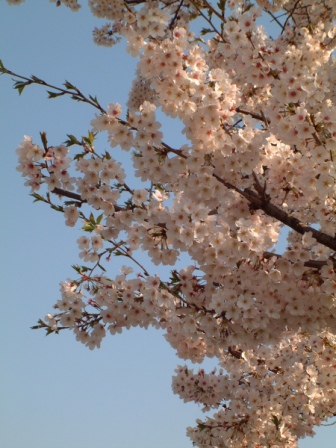
|
| Cherry Blossom 2 |
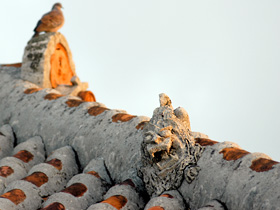
|
| Shisa on the roof |
Daruma Doll
Daruma Dolls reprent the pries Bodhidharma, a 6th century Indian priest known as the creator of Zen Buddhism, Bodhidharma
is reputed to have spent seven, some says nine years meditating in a cave facing the walls praying without moving or blinking
his eyes during those years of meditation his arms and legs atrophied and fell off.Apparently Bodhidharma dozed off during
meditation and in anger he cut off his eyes lids.
At New Year Time, many Japanese and corporations buy a Daruma Doll, make a wish and paint the left eye, when
the wish comes true they paint in the second eye to let Daruma see again then take to the shrine to burn it in the New Year.
Many politicians buy them and if they win the election they take it to a temple too to burn it.
Daruma Dolls are spherical made of papier-mache, painted red with no legs and arms, you can buy them at shrines
in the beginning of the year, fairs or at souvenir stores any time of the year.
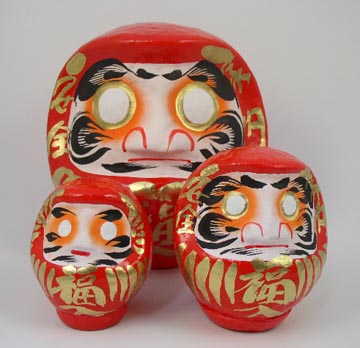
|
| Daruma Dolls |
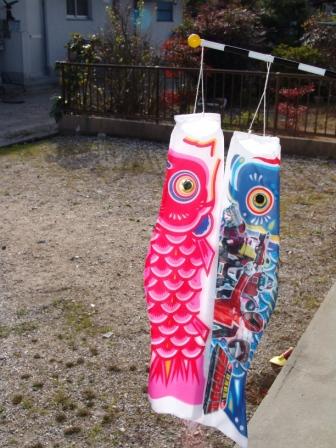
|
| My two Carp Kites for my two sons. |
Omamori
Omamori bukuro (Good luck charm in a brocade bag) is a charm that ensure safety of its owner.
Many temples and shrines sell these talismans and in some of them you can even find vending machines for it.
Omamori are made of paper or fabric and some valuable ones are made of gold or silver.Some luck charms are meant to be
kept in the house and others to carry around, there are no time limits on the effectiveness of the charms but some Japanese
like to replace their old charms with new ones every year.
If you take a cab in Japan it's likely you'll find one hanging by the rear mirror to avoid accidents.
The luck charms bears the name of the temple or shrine on one side and words of blessing on the other side good for health,
safe travel, safe driving, passing examinations especially for college, prosperous business, child bearing, easy delivery(very
popular too), or just for plain all around luck.
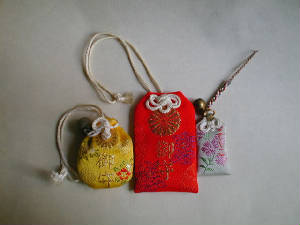
|
| Omamori(Luck Charm) |
Omikuji
Omikuji is a Japanese fortune telling, these written fortunes are obtained by drawing lots in the form of sticks from
a container the sticks are then exchanged for long narrow pieces of paper upon which good or bad fortunes are indicated, if
your paper brings a message of good luck you can take it with you but if it tells bad luck you have to leave it at the
shrine tied around the branch of a tree or in a special place where the shrine indicates, so the predicted
bad luck won't follow you.
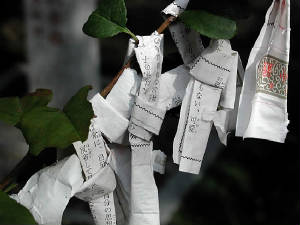
|
| Omikuji tied up on a tree |
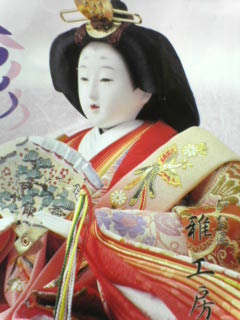
|
| Hina Ningyo up close |
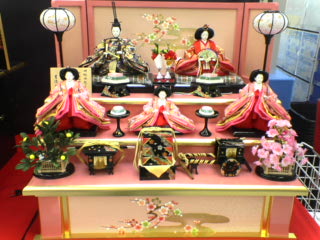
|
| Pink colored set |
Special thanks to my adorable Goddaughter Elsie(only 9 years old at that time) who went to a library in Tokyo
to help me find more interisting facts about the Hina Ningyo.
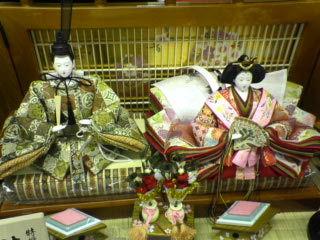
|
| Hina Couple |
Setsubun
Seasonal division between Winter and Spring is a festival held on February 3rd or 4th, one the before the start of Spring
according to the Japanese Lunar Calendar(Tradition and Calendar idea imported from China based on the cycle of the moon),
Setsubun is not a national holiday, but for many centuries the Japanese have been performing rituals with the purpose of chasing
away evil spirits.
There are many different rituals of Setsubun, nowadays the most common ritual is Mame-maki, throwing roasted
beans around the house and at temples and shrines across the country.
Many Japanese go to temples or shrines either to throw or catch thrown soy beans, they believe that the ones who throw
the beans will have their spirits purified and the ones catching them will have luck through the coming year.
When throwing the beans they shout ''Oni wa soto'' ''Fuku wa uchi'' (Demons out, Fortune in), afterwards they
pick up and eat the number of beans accordingly to their age to ensure health and luck.
Another new tradition created in Osaka and spread all over Japan through convenience stores is buying the maki-sushi
(roled sushi) and eating them quietly while making a wish always facing to the same direction which changes every year
according to their rules.
On the night of Setsubun, many Japanese decorate a holy tree in front of their houses with a head of a sardine, a clove
of garlic or a onion, such talismans are designed to keep evil away as the New Year approaches.
Families with children always look forward to this day because mame-maki can be a lot of fun, one person acts
as the goblin and runs around while the others throw beans at the person and at some schools the students make Oni,
goblin masks to play around.
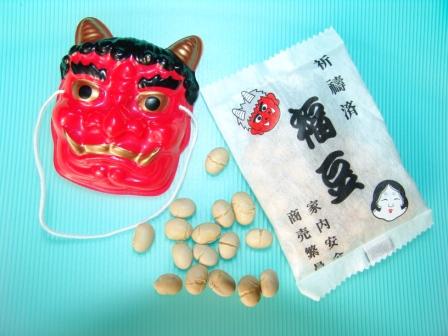
|
| Set of Oni mask and Happiness Soy Beans |
Back to top
Back to Homepage
|
 |
 |
 |
|
Stupids never catch a cold
''Baka wa kazehikanai'', I often hear my japanese friends tell me that when my whole family gets a flu and they
don't, a polite way to say ''Oh, you're wise''.
I can't feel more stupid when they say that because if they're the healthy ones that never get sick they are supposed
to be having a healthier life style than I provide my family.
If you catch a flu while in Japan and someone says that to you, thank her/him.
What I'm going to add here is not a belief but funny, if someone sneezes don't say ''God bless you'', japanese
never wish one for health while sneezing the one who sneezes is supposed to say ''I'm sorry for sneezing''(SHitsureitashimashita).
The ghosts of Okinawa
Okinawa is the most beautiful island located in the south of Japan with many US military bases also haunted by ghosts.
If you ever ask an Okinawan about haunts and ghosts don't be surprised if they quickly change the subject.Okinawans are
uneasy talking about the dead and avoid any supernatural contact at 2 am. the haunted hour.
That's the reason houses were built with a lion-dog(Shisa or Shishi) with a scary face like a dragon on the roof
of most of the civilians homes, they believe the scary monster statue will scare the dead spirits away.
Each Shisa is hand made so you won't find two alike.
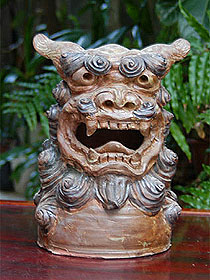
|
| Shisa's head |
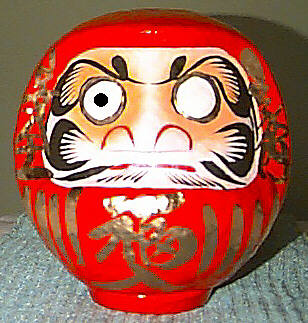
|
| Daruma Doll with one eye painted |
Maneki Neko(Cat)
Maneki Neko appeared suddenly when the Edo period(Samurai time, around 1800) was over.
In Edo period the country created an amuzement town for men called Yuukaku full of houses in Japanese style with hostesses
and prostitutes, each house had a luck talisman of the male sexual organs made by different materials.
With the modernization of the country in the Meiji period from 1868, government prohibited under the law from
the year 1872 the houses to display sexual organs on its shelves.
Japanese prostitute was expressed as a cat at that time in substitution to the sexual organs talismans they displayed
cats waving one paw beckoning showing the palm of the hand imaging a prostitute gesture of invitation.
A different Legend says that Maneki Neko was made in honor of a pet cat called Tama who invited a wealthy man running
from the rain into the temple in a time that poverty had striken it, after that the man and the priest who owned the
cat became friends and the temple became prosperous after that and the priest and the cat never went hungry again, after the
cat died he was buried in the Goutokuji shrine's cemetary, which I doubt to be the true story.
Then Maneki Neko spread all over Japan as a good luck doll of flourishing business.
You can buy them in any souvenir stores made from many materials, colors and types from key rings to whatever Japanese
imagination created until these days, most of them are white, but if you find a black one the meaning is different it is suppose
to ward the evil spirits off and the even more rare red ones are to prevent sickness.
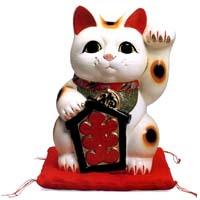
|
| Maneki Neko |
Hina Ningyo and the Hina Matsuri
The origin of Hina Matsuri (Doll's Festival) is an ancient Chinese practice in which the sin of the body and misfortune
are transferred to a doll and then removed by abandoning the doll on a river.This tradition begun in China celebrating the
Doll's Festival on March 3rd, according to Chinese custom this is the first day of the serpent season.Japan inherited this
tradition and changed the name to ''Momo no Sekku'' (Peach Festival) instead of Serpent, which is more suitable for
the season since it's the time peach blossoms are in bloom.
THe ancient festival was about taking a straw doll and float it down the river to wash away all the illness and bad luck
for one year, but then during the Edo period(1603-1867) the festival was popularized as a girl's festival(Hina Matsuri), some
old fashioned people still like to float paper dolls down the river late on the afternoon of March 3rd, doing the ''Hina
Okuri'' (Sending away the doll) or also called ''Nagashi bina'' (Floating away the doll).
The present Hina Matsuri comes from the combination of a doll(called Hina) play during the Heian period(798-1185) and
Nagashi bina floating away paper dolls.
Therefore displaying Hina Ningyo(dolls) is a tradition where the family (parents and grandparents) wish that the
girl will grow healthy and be a caring woman to have a happy marriage.
One of the most interesting aspects of this festival are the cerimonial dolls, a full Hina Ningyo set consists of an
Emperor and Empress(Juuni Hitoe dressed with twelve layers of fabric ceremony robe)a Kimono still worn at a
Royal's family wedding ceremony, then below three court ladies, five musicians, two ministers and three servants they
are displayed with the Emperor and Empress on top
and so on and among it peach blossoms, the traditional special dish Hishimochi(diamond shaped rice cakes colored
red or pink to off the evil spirits, white for purity and green for healthy) and various miniature pieces of furniture.
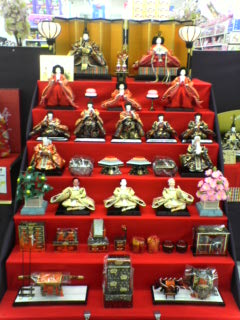
|
| Complete Hina Ningyo set from Toysrus store in Japan |
A traditional set of dolls can be very expensive.There are many grades for the sets and they vary from 100.000 yen(around
900 Us dollars) to a million yen(around 9 to 10 thousand US dollars in 2005), unless there is a set in the family passed
from grandparents to the following generation, however since many Japanese live in small houses buying only
the Emperor and the Empress is popular nowadays.
There is a superstition that if the dolls are not stored soon after the festival, the girl will be doomed to marry late,
every year the dolls are taken out only for this festival and restored again for the next year.
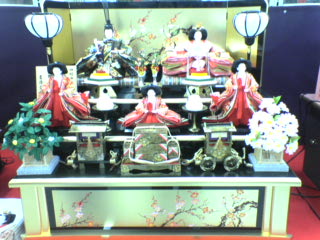
|
| Smaller set equally expensive for its detailed manufacturing |
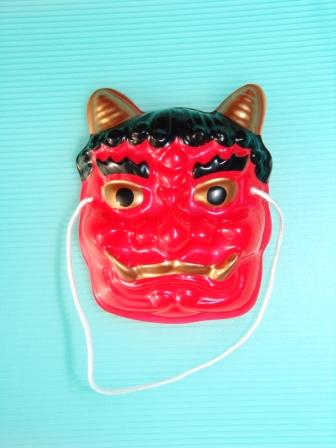
|
| Oni (Goblin) Mask |
|
 |
|
|
|

